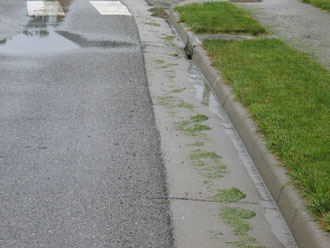Improper Mowing of Lawns Can Impact Water Quality
Cutting turf and impacting water quality sound like completely unrelated topics. However, the improper handling of clippings is a very important way in which nutrients are inadvertently introduced into our water sources. What is the form of the nutrient? Well, it is not a standard chemical fertilizer, but for all intents and purposes it is ‘slow release fertilizer’: it’s your clippings. The leaf blades and stems that are discharged by your mower are comprised of all the nutrients required for plant growth and development. In general, your lawn clippings contain around 4% nitrogen, 0.5 to 1% phosphorus, and 1 to 2 % potassium by weight. And it is the nitrogen and phosphorus that are major concerns for water quality as they both can incite eutrophication of water sources. Eutrophication occurs when nutrient levels in the water become so large that prolific algal blooms occur; these algal blooms consume most of the oxygen in the water and other desirable plant and animal life dies.
So, you now see the link between lawn clippings and eutrophication. But let me defend my turf… pun intended! The reason clippings can contribute to eutrophication is us, not the turfgrass. When you make those first few passes with the mower along the street, do you think to throw the clippings back into the lawn, or, as many seem to do, into the street? Or worse still, have you ever seen folks take their leaf blowers and blow piles of clippings into the street in order to clear their sidewalks, driveways, or lawns? The next time it rains, where is all this slow-release fertilizer headed? Straight to the nearest storm drain and eventually to a local water source.

Fortunately, the solution to this problem is pretty simple. Put the clippings to work for you by returning them to the lawn. Hence, they remain out of the water supply and given their nutrient value, you take advantage of the slow-release fertilizer for your turf and simultaneously feed the microbes that live in your soil. If a few clippings do accumulate on your surrounding hardscapes, blow or broom them back into the lawn. If your lawn looks like a hayfield after mowing, then the turf is giving you a clue regarding your current mowing program – it’s not right! The rule of thumb for proper mowing is to never remove more than 1/3rd of the leaf blade in a single mowing event. If the grass gets away from you, mow it high, mow it often, and slowly but surely return it to the recommended cutting height. And if clipping accumulations are so great on your lawn that they have to be removed because they are blocking the sunlight from reaching the lawn and/or inciting disease (or the real reason… they look so bad), then consider collecting and composting them. Clippings can make a great source of the ‘greens’ that you add to the ‘browns’ in your compost pile.
And even your mowing equipment can help you better manage clippings. Mulching mowers are specially designed to chop clippings into fine particles, that in a properly mowed lawn, are basically invisible on the surface.
There are a host of publications and resources available that detail best management practices in lawn care at the Virginia Cooperative Extension website. And be sure to check other archived podcasts on the Turf and Garden Tips website.


